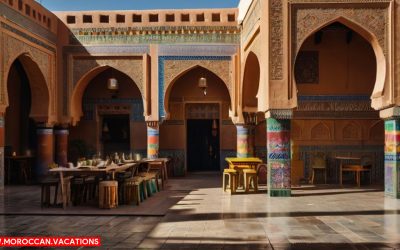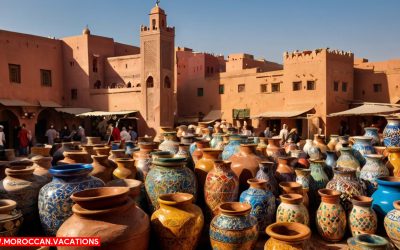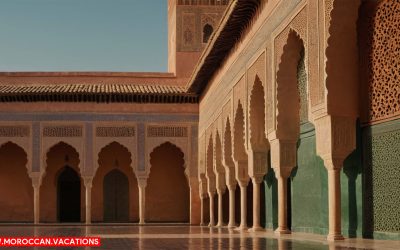History of Moroccan Carpet Weaving
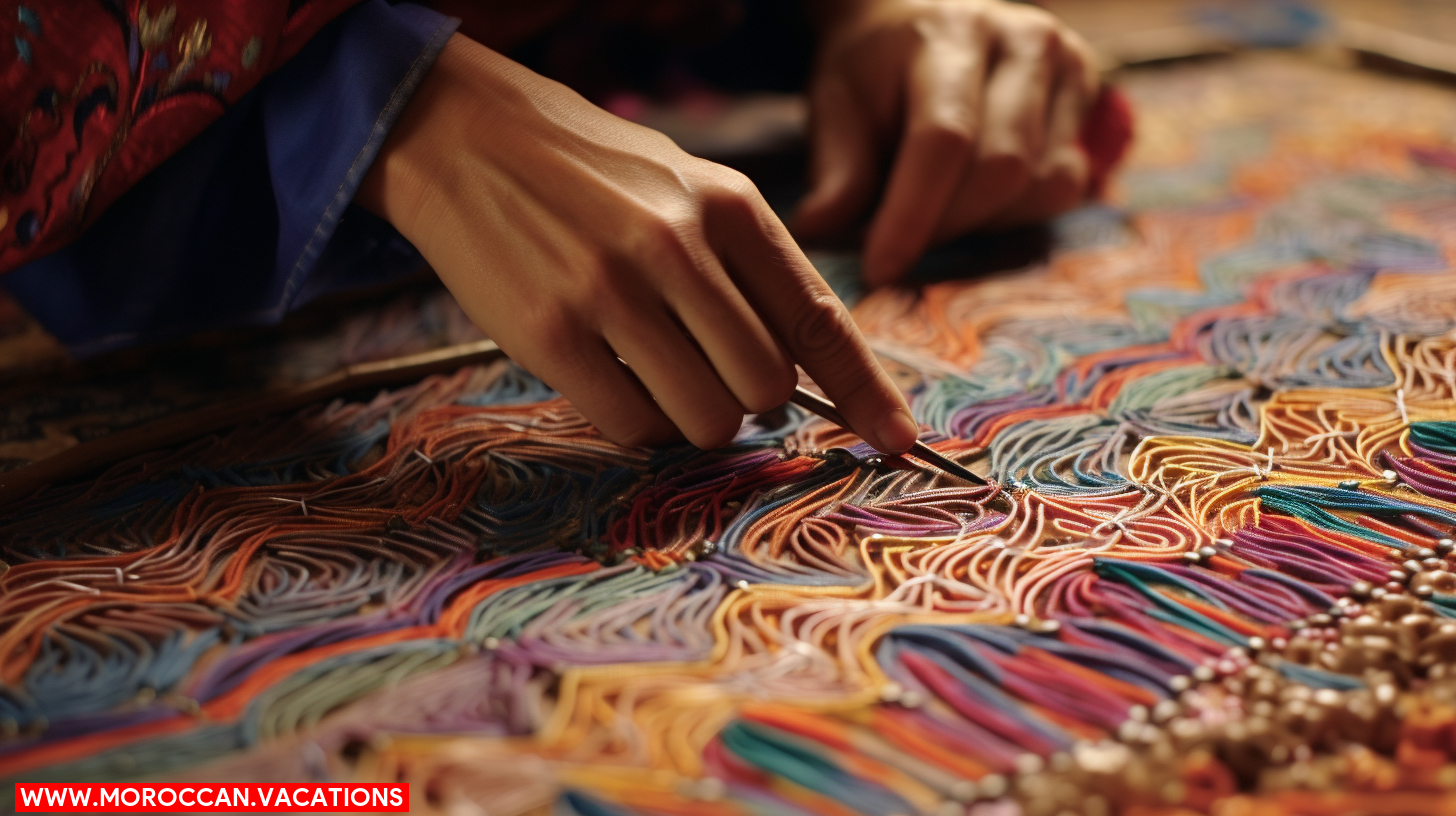

You’re about to embark on a fantastic journey, diving into the vibrant world of traditional Moroccan carpet weaving. You’ll marvel at the intricate techniques, decipher the rich symbolism, and appreciate the cultural significance of this awe-inspiring art form. You’re not just learning about carpets; you’re unlocking stories woven into each thread. So, let’s unravel the mysteries of this ancient craft together. It’s more than just a rug, it’s a testament to centuries of Moroccan heritage.
Diving into the history of Moroccan carpet weaving, you’ll find that it’s an ancient art form, with roots stretching back to the Paleolithic era. It’s a craft passed down through generations, each era adding its touch while respecting the old ways. You’ll appreciate the influence of the Berber migration on this art form. The Berbers, indigenous people of North Africa, significantly impacted the weaving techniques, patterns, and symbolism found in Moroccan carpets today.
But it’s not just about the craft, it’s about the craftswomen too. The women’s weaving role has always been prominent in Moroccan society. They’ve been the keepers of this tradition, their skilled hands and creative minds giving birth to the myriad patterns and colors that define Moroccan carpets. Each carpet tells a story, and it’s these women who’ve been the storytellers for centuries.
The weaving of these carpets isn’t just an art, it’s a symbol of freedom. The freedom to create, to express, to tell stories through patterns and colors. It’s a testament to the resilience and creativity of the Moroccan people, a celebration of their rich cultural heritage.
Understanding Carpet Weaving Techniques
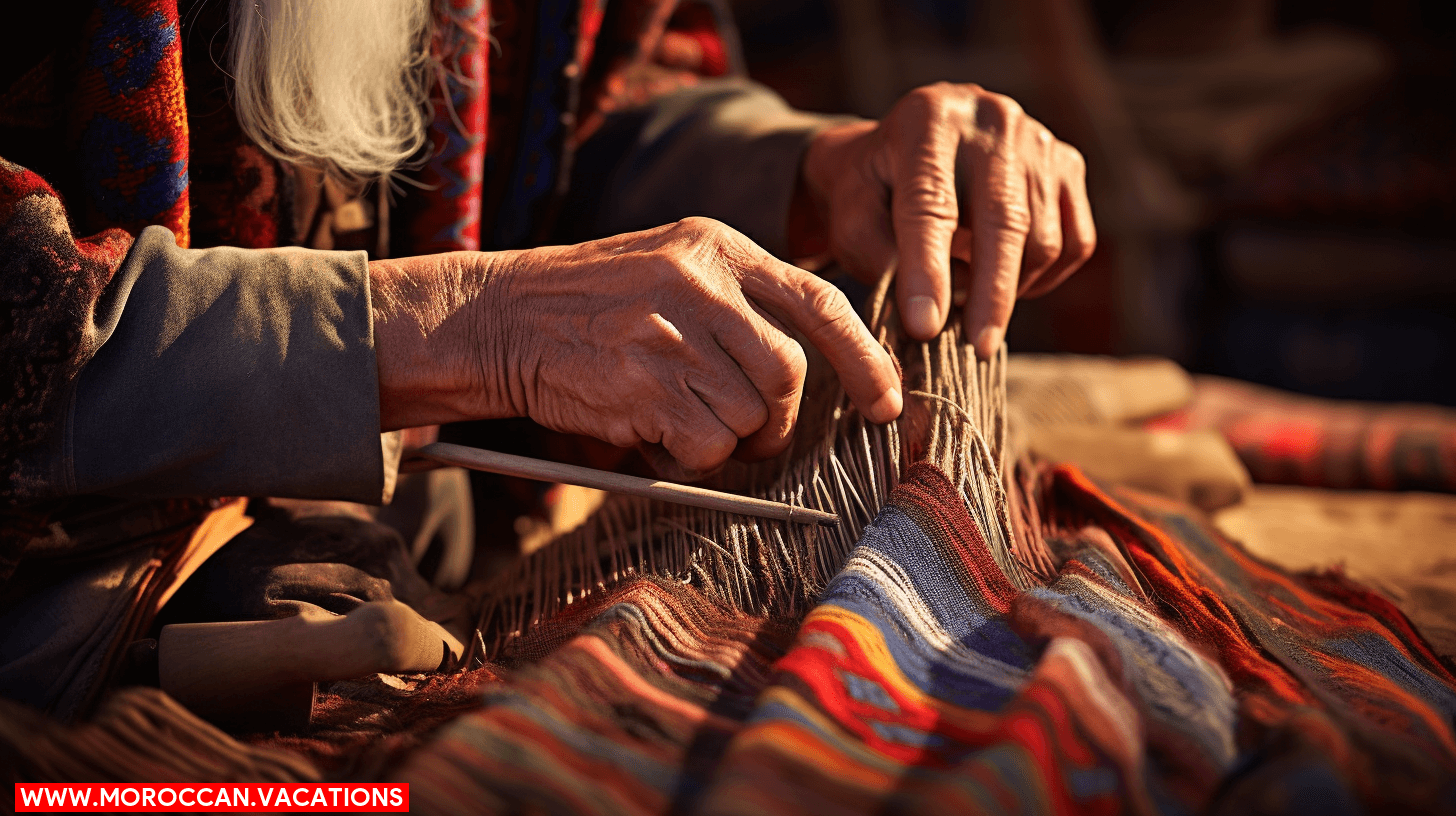

Now, let’s delve into the heart of Moroccan carpet weaving by breaking down the traditional techniques you’ll come across in this intricate art form. The weaving loom functionality is paramount in this process, and understanding it gives you a sense of the skill and patience required.
The weaver sets up the loom vertically, stringing it with warp threads. The tension of these threads impacts the carpet’s durability, one of the critical factors in its longevity.
Then, the weft threads are woven through, creating the base structure. The techniques used here can vary, but typically, a flat-weave technique is employed, which ensures a durable, tight weave.
Finally, the knots. Each one is tied by hand, using a variety of techniques that influence the final pattern and texture of the carpet. The density of these knots is also a key factor in carpet durability.
As you can see, Moroccan carpet weaving isn’t just about creating beautiful designs. It’s a complex process requiring an understanding of the weaving loom’s functionality, the factors affecting carpet durability, and the techniques used. It’s a testament to the weavers’ skill, patience, and artistic vision.
The Role of Color in Moroccan Carpets
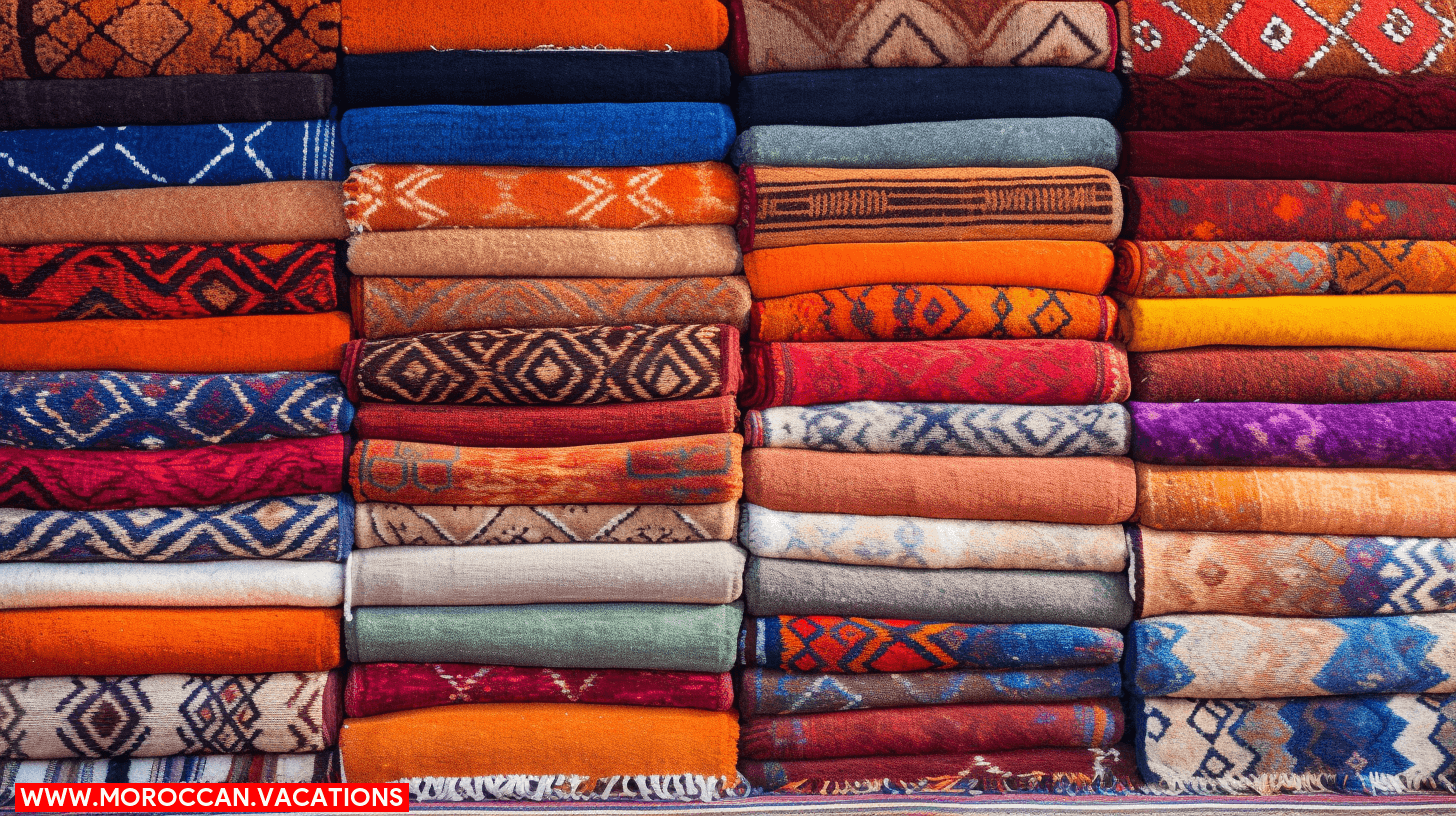

As you delve further into the art of Moroccan carpet weaving, you’ll discover that the choice of color is not a mere aesthetic decision, but carries deep symbolic and cultural meanings. Each hue is a testament to the artisan’s understanding of color psychology, interwoven with the threads of Morocco’s rich history.
Take a moment to appreciate the dyeing processes. The vibrant colors aren’t just for show; they’re a manifestation of the weavers’ freedom of expression. Reds and oranges, derived from the madder root, signify strength and protection. Blues and greens, obtained from indigo and mint, stand for peace and life. The use of yellow, often extracted from saffron or pomegranate, symbolizes eternity.
Keep in mind, these aren’t arbitrary associations. They’re deeply ingrained in Moroccan culture. For instance, the preference for warm colors may reflect the country’s desert landscapes, while the cooler tones might mirror its coastal areas.
Decoding the Symbolic Patterns
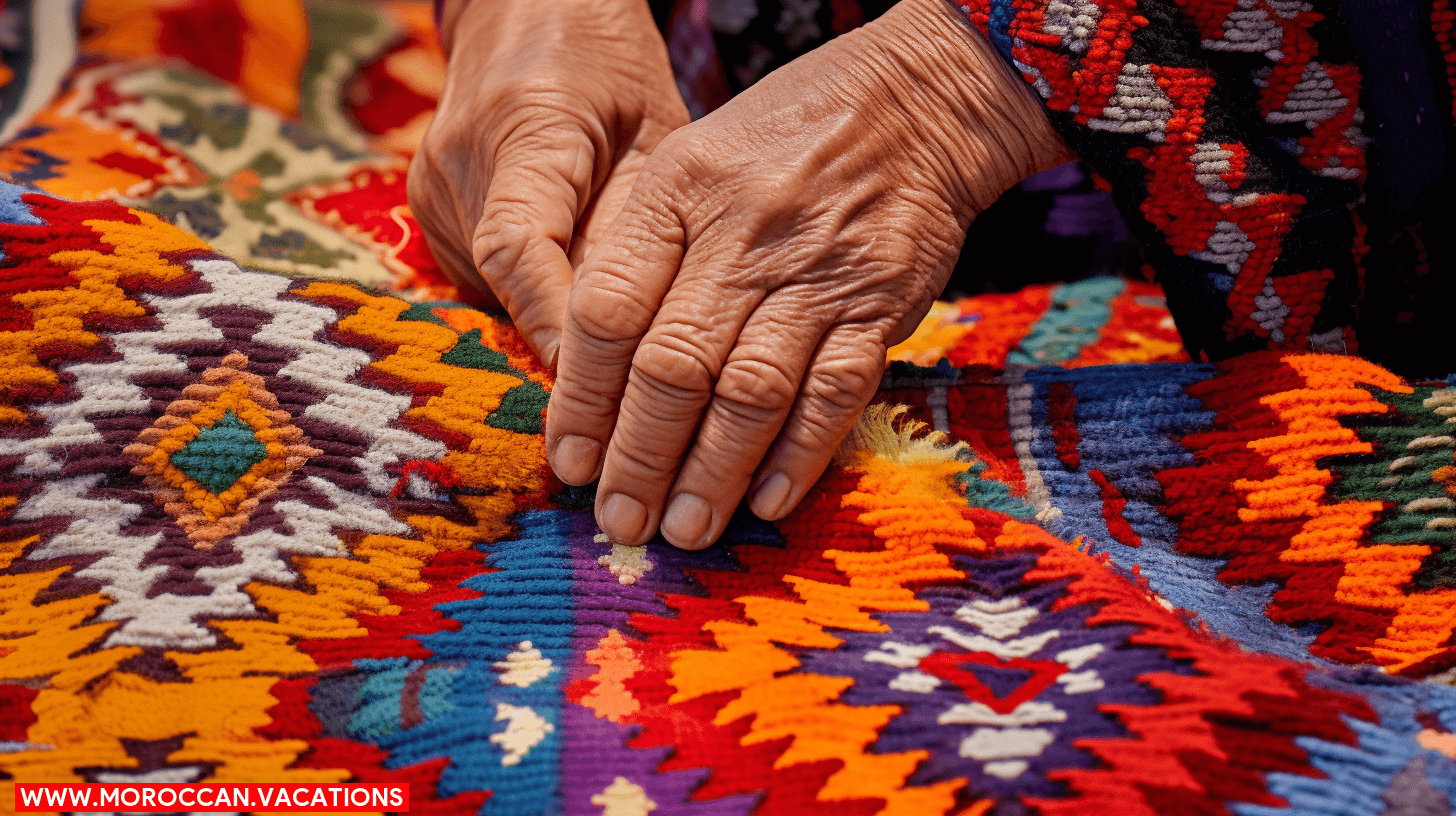

You’ll find that the intricate patterns in Moroccan carpets aren’t just artistic designs; they’re symbolic narratives that tell unique stories. These patterns, often passed down through generations, hold profound cultural significance. Pattern interpretations and the symbolic evolution of these designs offer a fascinating glimpse into the weavers’ lives, their beliefs, and the society they inhabit.
The diamond shape, for instance, symbolizes femininity and protection against evil spirits.
The zigzag, on the other hand, signifies water, life, and fertility.
The X shape represents the scorpion, a recurring symbol of strength and protection.
The evolution of these symbols over time is particularly interesting. For example, the zigzag might have initially symbolized the flow of a river, but over time, it has taken on a broader meaning of life and fertility. This is indicative of a society that values freedom and the capacity to adapt and reinterpret their heritage.
Decoding these patterns allows us to appreciate the beauty of Moroccan carpets on a deeper level. They’re not just decorative items, but woven narratives, offering a glimpse into the rich tapestry of Moroccan culture and history.
Artistic Influences on Moroccan Weaving
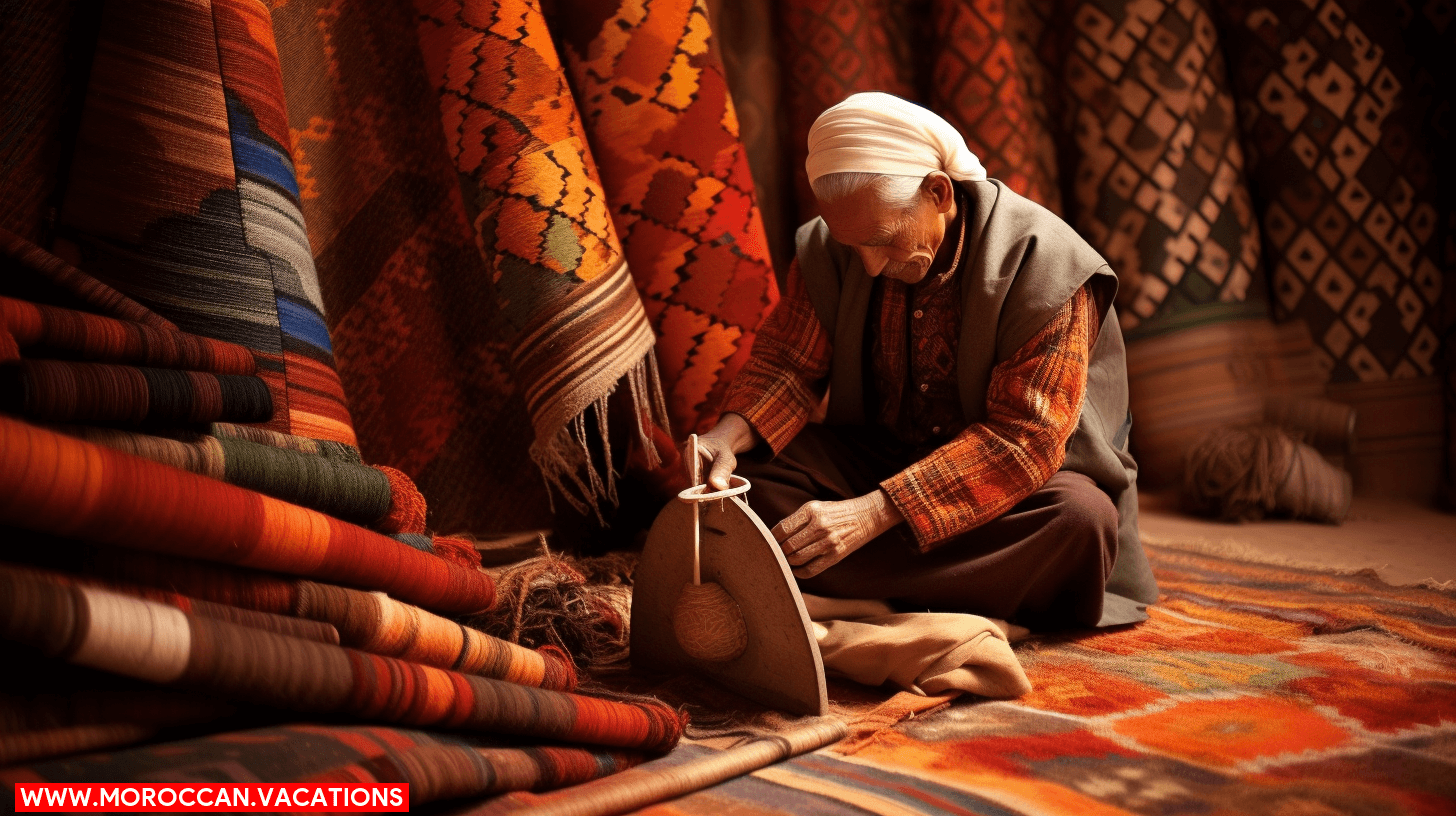

Dive into the myriad of artistic influences that shape traditional Moroccan weaving, allowing for a vibrant and distinctive aesthetic. This craft, while deeply rooted in local customs and traditions, is not isolated but continually evolves, reflecting the flux of time and culture.
Weaving innovations play a significant role in shaping the artistic landscape of Moroccan textiles. You’ll see modern designs juxtaposed with ancient patterns, creating a harmonious blend that speaks volumes about the adaptability of this centuries-old craft.
International influences also permeate Moroccan weaving, a testament to the country’s openness to the world. Elements from Sub-Saharan Africa, the Middle East, and Europe have found their way into the Moroccan weaving tapestry, enhancing its richness and diversity.
Yet, Moroccan weavers have skillfully managed to incorporate these international influences without losing their unique identity. They’ve done it in a way that liberates rather than constrains, demonstrating the freedom inherent in creativity. So, as you explore Moroccan weaving, appreciate not just the patterns and symbols, but also the interplay of influences that make it a living, evolving art form.
The Cultural Significance of Carpet Weaving
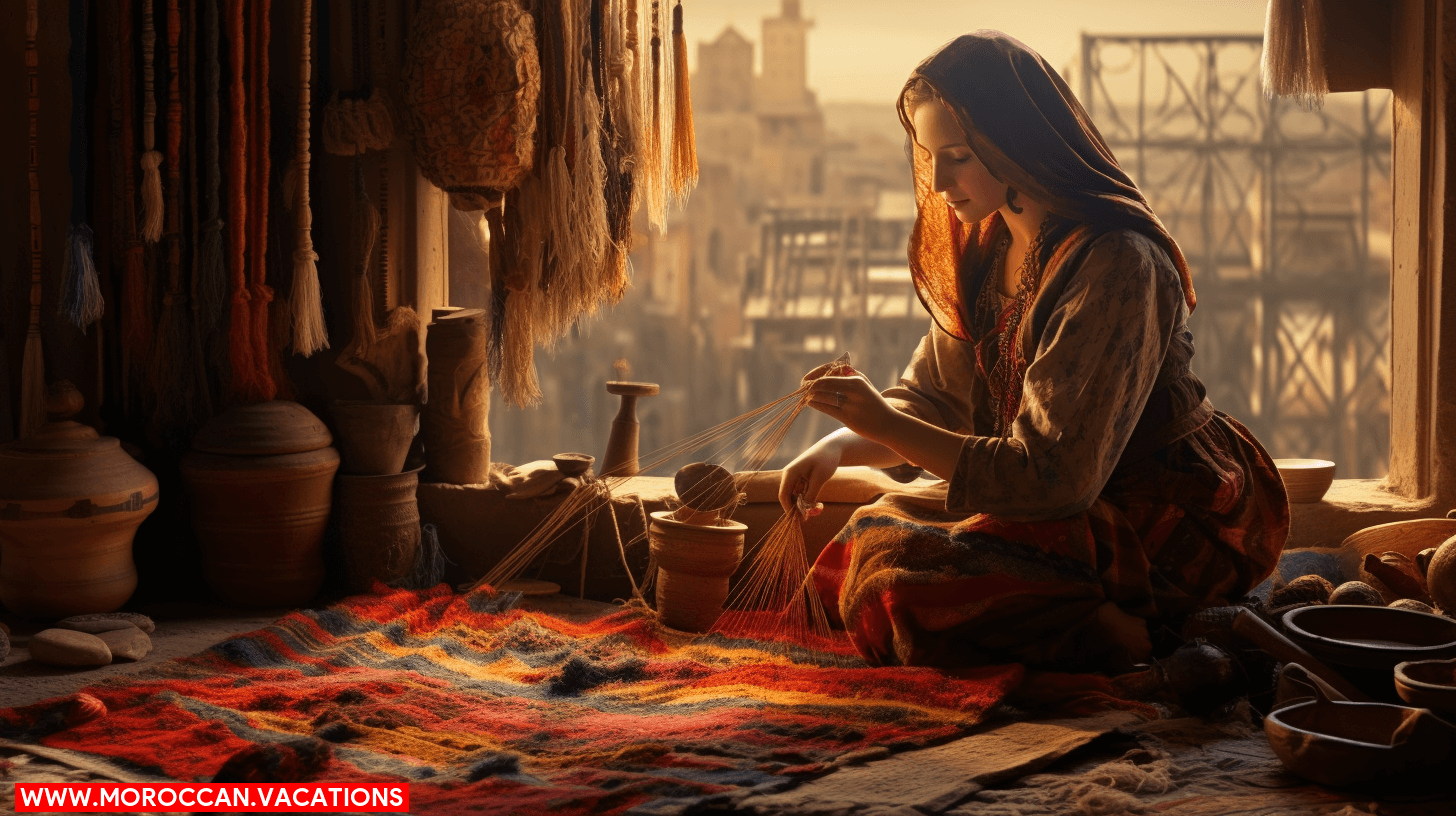

In your journey through Moroccan weaving, you’ll soon realize that carpet weaving isn’t just an artistic expression; it’s a significant cultural practice deeply intertwined with the nation’s history and way of life.
Weaving rituals play a crucial role, not only in the creation of these carpets but also in the social fabric of Moroccan communities. They serve as a means of communication, a time for social bonding, and a continuation of age-old traditions.
The cultural significance of carpet weaving in Morocco can be further understood through:
– The economic impact of the craft on local and national levels. Carpet weaving offers a means of livelihood for many Moroccans, particularly women, contributing substantially to the local economy.
– The intrinsic role carpets play in Moroccan daily life and celebrations. They are central to special occasions like weddings and are seen as a symbol of family heritage and status.
– The deep-rooted traditions and techniques passed down through generations, preserving the country’s rich cultural identity.
Look deeper into the weave, and you’ll uncover a vibrant tapestry of stories, beliefs, and values that are as colorful and intricate as the carpets themselves.
Materials Used in Traditional Weaving
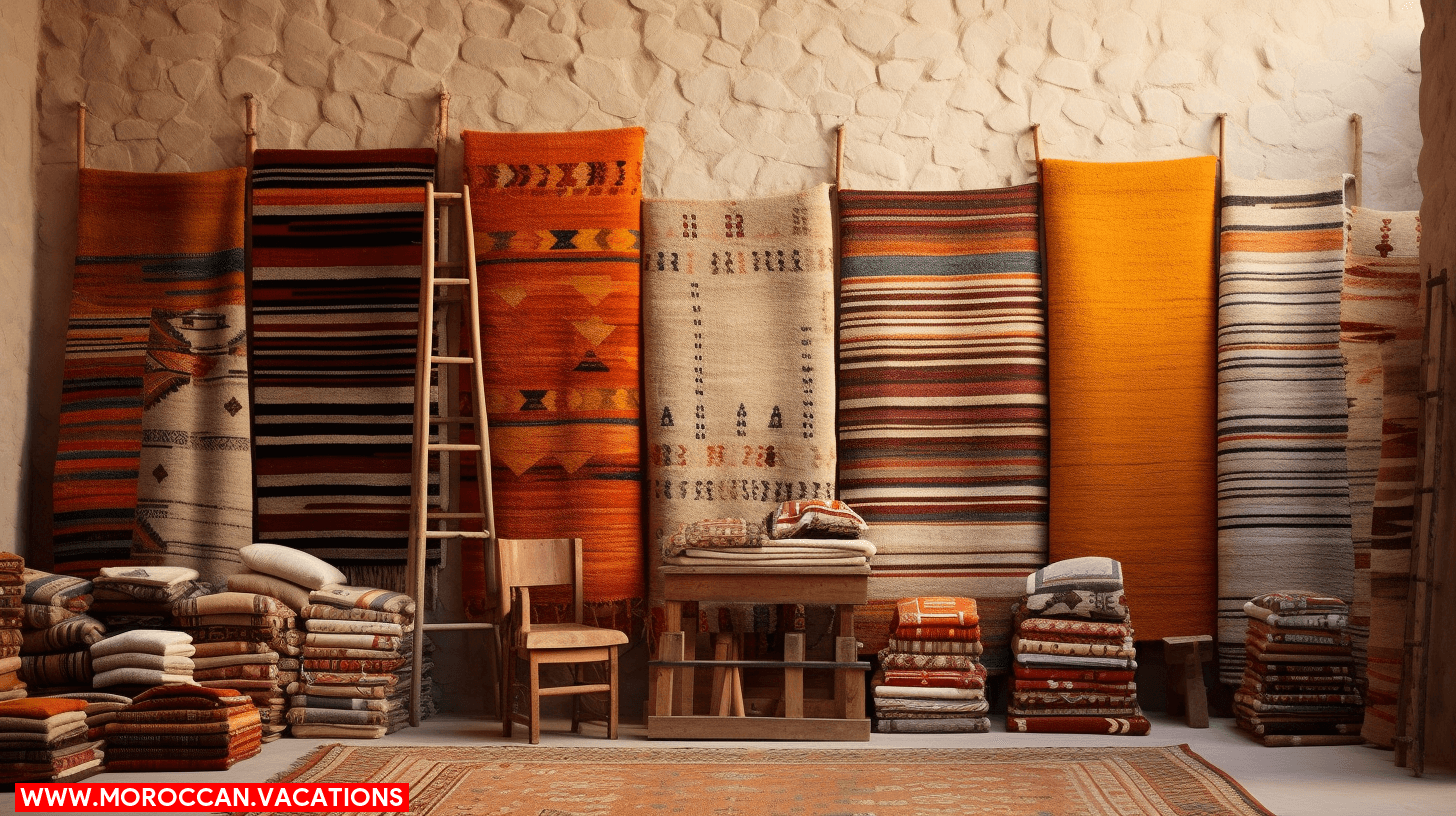

As you delve into Morocco’s traditional weaving practices, you’ll find that the craftspeople’s choice of materials is integral to the unique characteristics and quality of each carpet. Primarily, wool, cotton, and silk are used, each contributing its own unique texture, durability, and aesthetic appeal.
Weaving tool innovation plays a pivotal role in the process. Traditional looms, made of wood and metal, are still in use today, yet there’s an increasing shift towards more sustainable materials and technologies. This transition is not just about embracing modernity; it’s also about reducing environmental impact, a topic that’s gaining traction within the weaving community.
An environmental impact assessment is crucial to understand the implications of material sourcing. The choice of wool, for instance, is not without its consequences. Overgrazing by sheep can lead to soil degradation and loss of biodiversity. Therefore, it’s imperative to source materials responsibly, balancing the need for quality and tradition with the duty to protect the environment.
Modern Adaptations of Traditional Techniques
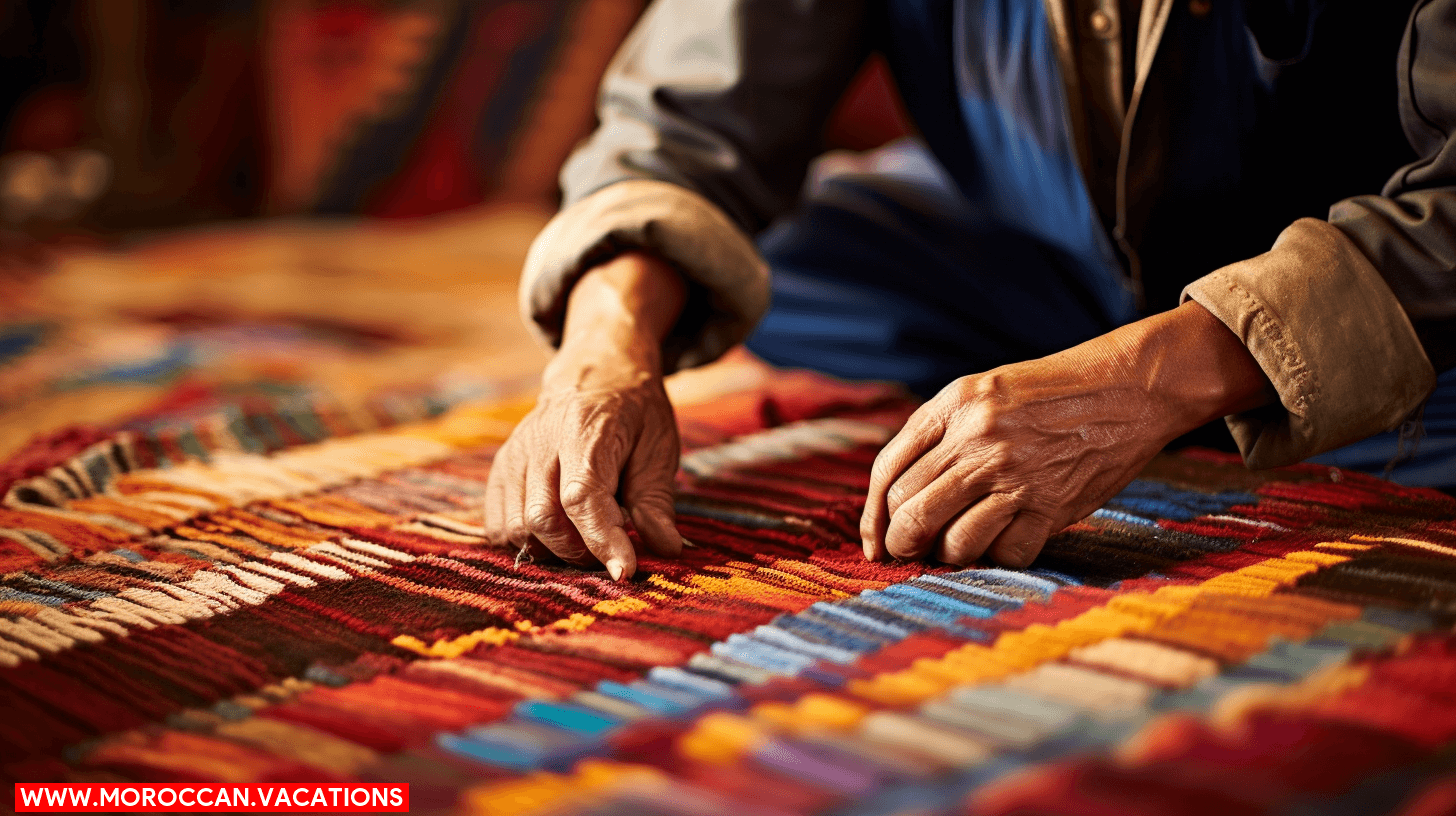

You’ll find that Moroccan weavers aren’t just preserving age-old techniques; they’re adapting them to meet the demands of the modern world. Weaving innovations are continuously emerging, blending traditional methods with new approaches to cater to modern tastes and sustainability efforts.
– Moroccan weavers are increasingly using recycled materials in their designs, demonstrating both creativity and commitment to the environment. This not only reduces waste but also introduces a unique aesthetic to the carpets.
– Advanced looms are being employed, allowing weavers to produce more intricate designs at a faster pace. However, they’re cautious to retain the distinct handcrafted touch.
– Digital platforms have become a game-changer, providing a global marketplace for these artisans. This allows the weavers to maintain their craft while reaching a broader audience.
These adaptations showcase the resilience of Moroccan weaving culture. The weavers’ ability to innovate while preserving their cultural heritage is a testament to their commitment to their craft. As a lover of freedom and creativity, you’ll appreciate the adaptability and tenacity displayed by these artisans. Their work is not merely a product but a living, evolving testament to their culture, creativity, and dedication to sustainability.
Stories Told Through Moroccan Carpets
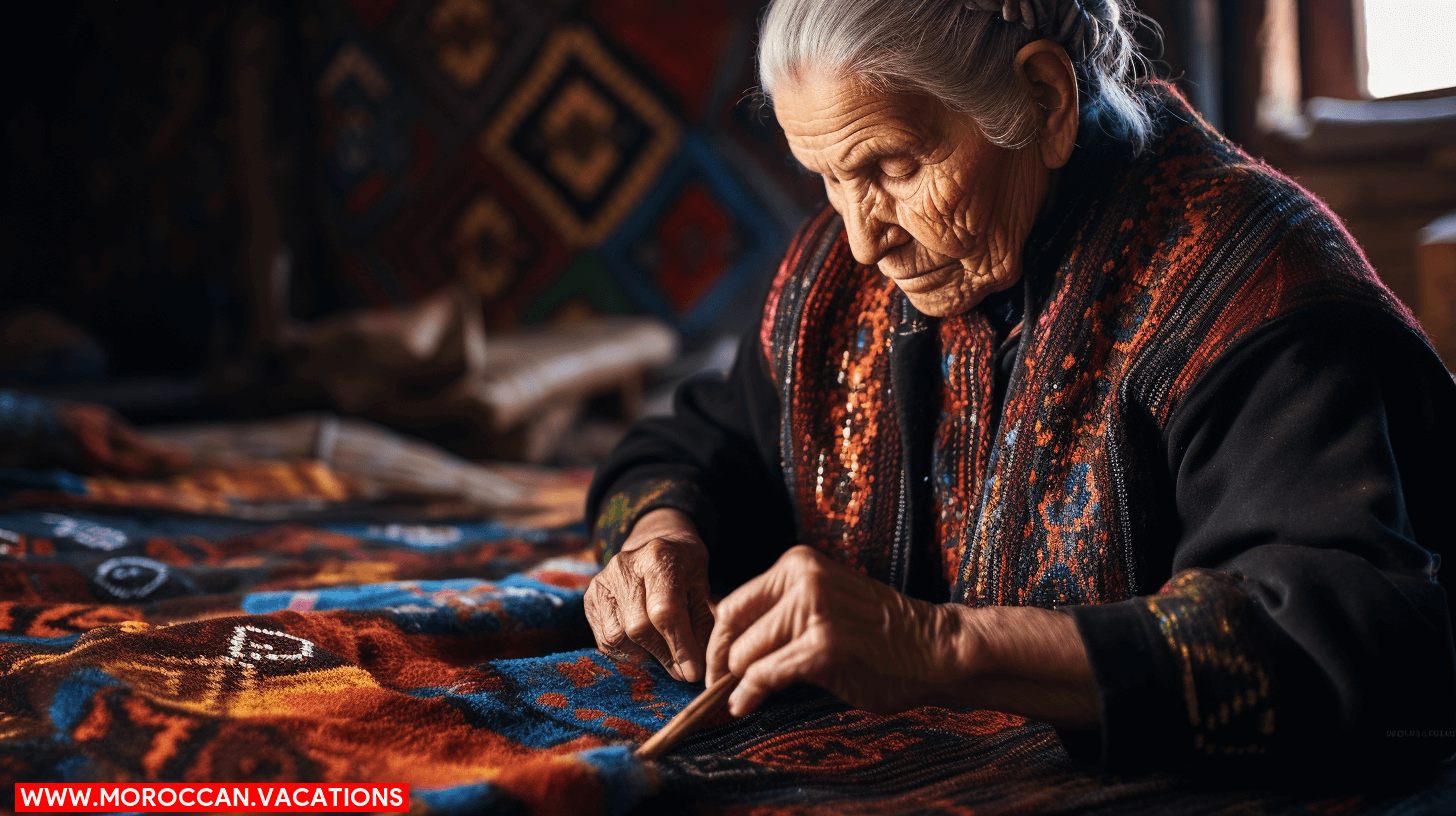

When you closely examine a traditional Moroccan carpet, you’re opening a book filled with stories from a rich cultural heritage. Each pattern, color, and knot is a word, a sentence, a chapter in a tale steeped in traditional symbolism and history. The carpet trading economics aren’t just about money, they’re a conduit for these stories to travel, spreading their messages far and wide.
Dive deeper and you’ll discover inspirational folklore themes, intricately woven into the fabric of each carpet. Every artisan weaves their own life experiences, hopes, and dreams into their creations, using age-old techniques passed down through generations. Themes of freedom, resilience, and courage are common, resonating with an audience that cherishes these values.
You’re not just looking at a carpet, you’re reading a story, understanding a culture, and connecting with a people’s spirit of freedom. From the Atlas Mountains to the bustling markets of Marrakech, these carpets carry messages of inspiration, resilience, and cultural pride. They’re not simply products of an economic trade, but embodiments of a rich tradition, a living testament to the spirit, creativity, and resilience of the Moroccan people.
Introducing Ayoub Karbachi, a brilliant wordsmith and curator of the Moroccan Vacations website. Prepare to immerse yourself in mesmerizing narratives and extraordinary moments, as he unveils the allure of Morocco's captivating destinations like never before.
Related Articles
The Intersection of Tradition and Modernity: Marrakesh's Art Scene
The Rich Heritage of Marrakesh's Art Step into the vibrant world of Marrakesh's art scene, where tradition and modernity collide in a captivating dance. Here, ancient crafts intertwine with contemporary artistry, creating a tapestry of creativity that will leave you...
Marrakesh's Art Workshops: A Hands-On Experience of Creativity
Exploring Marrakesh's Artistic Heritage Are you ready to unleash your creative potential? Look no further than Marrakesh's art workshops, where you can immerse yourself in a vibrant culture and learn new techniques and mediums. These hands-on experiences will allow...
The Symbolism in Marrakesh's Architectural Details
Uncover the rich symbolism woven into Marrakesh’s architectural details. From intricate tilework to ornate carvings, explore the cultural significance behind the city’s stunning landmarks. Embark on a journey of discovery through Marrakesh’s hidden meanings and timeless beauty.

